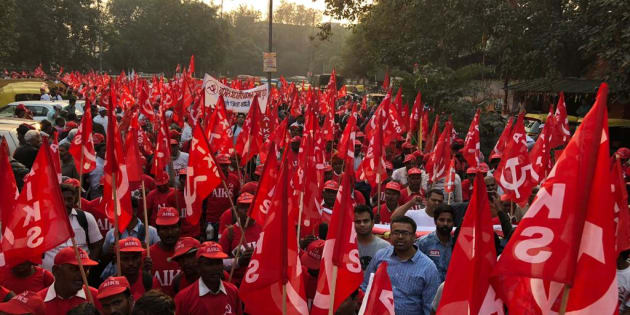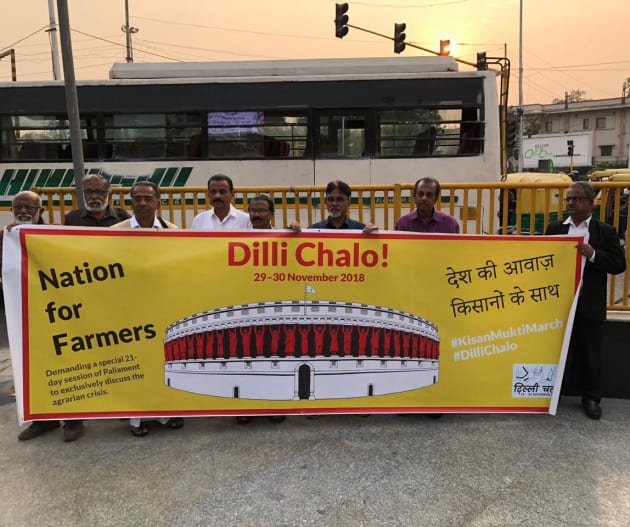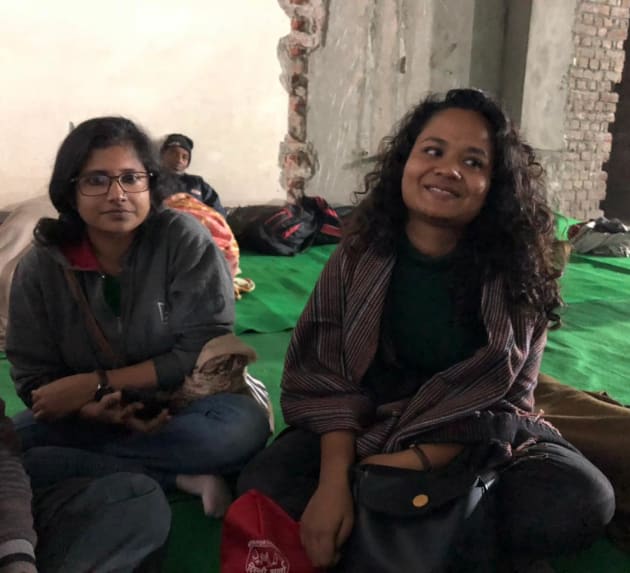Farmers’ March: The Artists, Activists And Students Behind The Scenes In Delhi | HuffPost India
The mobile phone of 28-year-old Janhavi, a Ph.D scholar at Delhi University, is constantly ringing on Wednesday. She rarely leaves the table at the corner of a library-cum-office in Katwariya Sarai in New Delhi, where she is making a chart and working on a laptop along with her friend Agneya.
Janhavi and Agneya are two among over 500 coordinators across the country who are volunteering to help the thousands of farmers who are marching to Delhi on 29-30 November to demand a special session of Parliament dedicated to the agrarian issues.
Janhavi was busy coordinating with her fellow coordinators and informing callers about the places where farmers will assemble, stay and march to Ramlila Maidan. She was also sending the contact numbers of volunteers appointed at four locations in Delhi to the farmers, who began reaching Delhi on Wednesday evening.
They are working out of the office of civil society group Indian Social Action Forum (INSAF), headed by activist Anil Choudhari.
“Do you think only the corporates have social responsibility? What about common people? The non-profit organizations also have a certain social responsibility. This farmers’ march is taking place to bring back agrarian issues to the mainstream and it can be done only when other sections of the society take an active interest in these issues,” Choudhari told HuffPost India.
Thousands of farmers from Rajasthan, Karnataka, Andhra Pradesh, Gujarat and other states have begun marching from four different routes into New Delhi. They will stay at the Ramlila Maidan on Thursday night before beginning their march to Parliament on Friday.
The march is being organised under the banner of All India Kisan Sangharsh Coordination Committee (AIKSCC), a confederation of around 200 farmers’ groups from across the country.
Artistes in solidarity
Around 12 km away, a group of artistes with banners saying “Dilli Chalo March” and “Nation for Farmers” are distributing leaflets at the corner of a square in ITO.
“We were in Karol Bagh on Monday, in Connaught Place on Tuesday and today we are here at the ITO,” said Komita Dhanda, an actor-director and member of theatre group Jana Natya Manch.
“There is food in our plates because a farmer somewhere in India is growing that for us, so it is important that we extend our solidarity to the farmers who will be coming to Delhi to raise their genuine demands… The perception of the city people is that these people ( farmers) marching to Delhi might create chaos and traffic problems here,” said Dhanda.
She added that many people only took the leaflets from them because they spoke English.
“When the farmers will march in Delhi, these leaflets might just remind them that these farmers are not here to create chaos but for their genuine demands which are ultimately going to affect everyone,” she added.
Over 40 artists and writers from Jana Natya Manch, Janwadi Writers, and Jana Sanskriti will also put up a stall near Rajghat on Thursday to distribute water and biscuits to the farmers.
Sudhanva Deshpande, a theatre artiste and a publisher, is wearing a placard which says “Save Farmer, Save Country”. Ignoring the agrarian crisis, he points out, will lead to serious consequences.
“Because ultimately it is going to affect us all.”
At the camp
On Wednesday night, Ramdash Shengde and 20 other farmers from Maharashtra’s Ahmednagar district reached Gurudwara Shri Bala Sahib near Sarai Kale Khan, one of the four locations in Delhi where arrangements had been made for the protesters to stay that night.
Deepali, a Ph.D. scholar at JNU and her friends were at the Gurudwara to help organisers such as Vijoo Krishnan, joint secretary of the All India Kisan Sabha.
“We can’t imagine our lives without farmers. It is as simple as that. The policies of the government are also affecting the farmers the way they are affecting students. We are in solidarity with the demand of farmers,” said Deepali.
Krishnan, who was in charge of the camp said that the Gurudwaras volunteered to prepare food for the tired farmers on Wednesday night, and also arranged breakfast for Thursday morning.
Krishnan was one of the organisers of the Nashik-Mumbai march earlier this year which saw many Mumbaikars reach out to help the protesters. That experience inspired the Dilli Chalo march.
“In Mumbai, the support from the middle classes was spontaneous. They saw the farmers marching and came to help. But here in Delhi, we are witnessing that (support from middle classes) even before the march, which is unprecedented,” Krishnan told HuffPost India.
Source: Farmers’ March: The Artists, Activists And Students Behind The Scenes In Delhi | HuffPost India





